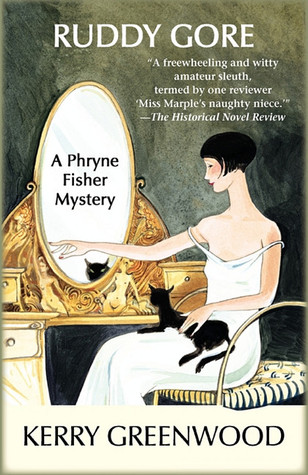Wednesday, August 21, 2013
"The hatchet flicked past, end over end, and struck a wooden shutter with a hollow thud... ...'Were you trying to attract my attention?' [Phryne] asked politely."
So begins the seventh entry in the Phryne Fisher mystery series. After the rather disappointing The Green Mill Murder, Phryne is back on form in Ruddy Gore, this time investigating a murder set in a theater during a performance of Gilbert and Sullivan's Ruddigore. The cast of characters is amusing and diverse, but we're also introduced to someone who sounds as though he'll be sticking around for the next few books, a lovely Chinese man by the name of Lin Chung who becomes Phryne's lover and confidant. I don't think it's necessary for me to go into detail as far as the synopsis; after all, this is a Phryne Fisher mystery. Going in, you know there'll be a mystery in which nothing and no-one is what or who they seem, truths will be uncovered, secrets will be kept by the sphinx-like Phryne as she deems prudent, and Dot will fret. And, as always, there'll be a secondary mystery in addition to the main one which will allow Phryne to fully flex her investigative muscles.
The one thing I noticed (and I can't remember if I ran into this problem in the previous books) is a strange bit of formatting with regards to the dialogue. Several times someone's response would be in the same paragraph, sometimes even the same sentence, as the other person's dialogue, making it confusing as to who was speaking. There were times when I had to reread something a couple of times to differentiate who exactly was doing the talking. Yes, there are times when you can have two people speaking in the same paragraph, usually with some exposition in the middle, which is okay as it usually denotes an immediacy to the conversation. But when it's done repeatedly or, more importantly, when someone's response comes right after the first person's dialogue, and I'm talking about in the same sentence, it makes the exchange unnecessarily confusing and, well, rather sloppy.
Aside from that formatting issue, though, once again I enjoyed becoming immersed in the Australia of the 1920s. Because of my particular peculiarities, I especially enjoyed all the details involving Phryne's (and to a certain extent Dot's) costumes and shoes. I'm a girly-girl that way. Not to mention the descriptions of the meals made by Mrs. Butler or served in the restaurants frequented by Phyrne made my mouth water (and Greenwood mentions food often, meaning I'm constantly slobbering as I read her books) and long for a life where I could have the luxury of snacking on homemade dishes prepared by a skilled cook. Basically, to live like Phryne. And who wouldn't want to live like that?
Read July 22-28, 2013
Reviewed August 21, 2013
Subscribe to:
Comments (Atom)
